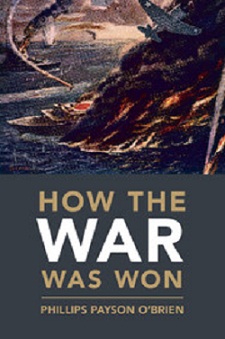New research reveals air and sea strategy behind victory in WWII
Published: 16 February 2015
Groundbreaking new research has revealed the extent to which the Second World War was decided, not by pitched battles on land, but by the superior air and sea power of the Allied forces.
Groundbreaking new research has revealed the extent to which the Second World War was decided, not by pitched battles on land, but by the superior air and sea power of the Allied forces.
The project uncovered evidence that air and sea power dramatically expanded the area of battle, allowing the Allies to destroy over half the Axis' equipment before it had even reached the battlefield.
 World War II is usually seen as being a titanic land battle decided by mass armies, most importantly those on the Eastern Front. Pitched battles such as El Alamein, Stalingrad and Kursk have become written into history as the arenas where the course of the war was decided.
World War II is usually seen as being a titanic land battle decided by mass armies, most importantly those on the Eastern Front. Pitched battles such as El Alamein, Stalingrad and Kursk have become written into history as the arenas where the course of the war was decided.
The research, published today in a major new book, ‘How the War was Won – Air-Sea Power and Allied Victory in World War II’, represents a major rethinking about how the Second World War was decided.
Research undertaken by Dr Phillips O Brien at the University of Glasgow, using thousands of pages of original documents, has shown that the Allies developed a predominance of air and sea power which put unbearable pressure on Germany and Japan's entire war-fighting machine from Europe and the Mediterranean to the Pacific.
For instance, the Battles of Kursk and El Alamein, which are often seen as decisive, actually destroyed relatively small amounts of German production. Combined, the loss of German tanks in both battles represented about 0.3 percent of annual German armament output. At the same time, individual air raids could destroy almost ten times as much production.
Dr O’Brien, Reader in History at the University of Glasgow, said: “There were no decisive battles in World War II. When we look at the figures, what we see is that the daily attritional loss of equipment was far more damaging to the German army than any great battle.
“The pressures that the Americans and British put on the Germans and the Japanese meant that by 1944 the Axis powers were losing a quarter of the aircraft they built without a firing a shot. They were lost as they were sent on their original deployment flights due to poor pilot training, fuel shortages or shoddy manufacture. This was far higher than the aircraft lost in any of the well-known battles.”
Williamson Murray, author of ‘A War to Be Won, Fighting the Second World War’, said: “It has become the conventional wisdom that the Soviet Union won the Second World War with only minor contributions from the United States and Great Britain. Phillips O'Brien has written a superb rejoinder to such nonsense in a work that represents a major contribution to our understanding of that terrible conflict. It needs to be read by anyone interested in World War II.”
David Edgerton, author of author of ‘Britain’s War Machine: Weapons, Resources and Experts in the Second World War and Warfare State: Britain 1920-1970’, said: “This is a book anyone interested in the Second World War will want to read. It refocuses the story of the war away from the battlefield, to the air and the sea, and also to the transit depot, the maintenance facility, the training base. This is an imaginative, cliché-busting work which lays bare exactly when, how and where the Axis lost the war.”
Media enquiries: nick.wade@glasgow.ac.uk / 01413307126
First published: 16 February 2015
<< February

